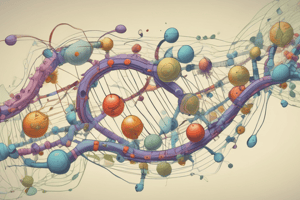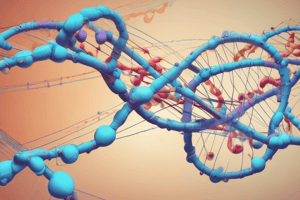Podcast
Questions and Answers
What is the main focus of Dr. Hannah Burgess's lecture on Translation in Eukaryotes?
What is the main focus of Dr. Hannah Burgess's lecture on Translation in Eukaryotes?
- Recap of the overall translation process
- Overview of translation in eukaryotes and the function of key translation initiation factors (eIFs) (correct)
- Comparison of eukaryotic and prokaryotic ribosomes and mRNAs
- Additional translational control mechanisms
What is the primary objective of Alberts' chapter 'Control of Gene Expression' in the Molecular Biology of the Cell, 7th Edition?
What is the primary objective of Alberts' chapter 'Control of Gene Expression' in the Molecular Biology of the Cell, 7th Edition?
- Comparison of eukaryotic and prokaryotic ribosomes and mRNAs
- Additional translational control mechanisms (correct)
- Recap of the overall translation process
- Overview of translation in eukaryotes and the function of key translation initiation factors (eIFs)
What does Dr. Hannah Burgess emphasize as a crucial aspect of Translation in Eukaryotes?
What does Dr. Hannah Burgess emphasize as a crucial aspect of Translation in Eukaryotes?
- Understanding the similarities and differences between eukaryotic and prokaryotic ribosomes and mRNAs
- Investigating additional translational control mechanisms
- Recap of the overall translation process
- The function of key translation initiation factors (eIFs) (correct)
What is the specific content covered in Alberts' chapter 'From RNA to Protein' in the Molecular Biology of the Cell, 7th Edition?
What is the specific content covered in Alberts' chapter 'From RNA to Protein' in the Molecular Biology of the Cell, 7th Edition?
Which organelle is responsible for the turnover of damaged or unfolded proteins, largely achieved by the proteasome?
Which organelle is responsible for the turnover of damaged or unfolded proteins, largely achieved by the proteasome?
What is responsible for tagging proteins with lysine 48-linked ubiquitin molecules for proteasomal destruction?
What is responsible for tagging proteins with lysine 48-linked ubiquitin molecules for proteasomal destruction?
In the context of protein stability, what contributes to overall protein levels and can be a target of control?
In the context of protein stability, what contributes to overall protein levels and can be a target of control?
What is the role of the Signal Recognition Particle (SRP) in the process of protein secretion?
What is the role of the Signal Recognition Particle (SRP) in the process of protein secretion?
What is the main organelle involved in targeting proteins to be secreted to the ER?
What is the main organelle involved in targeting proteins to be secreted to the ER?
Which step of translation initiation is considered the most regulated?
Which step of translation initiation is considered the most regulated?
What ensures correct start codon selection during translation initiation?
What ensures correct start codon selection during translation initiation?
What is targeted for destruction by the proteasome?
What is targeted for destruction by the proteasome?
What is the size of eukaryotic ribosomes?
What is the size of eukaryotic ribosomes?
Which complex is responsible for recognizing the 5' cap on the mRNA during translation initiation?
Which complex is responsible for recognizing the 5' cap on the mRNA during translation initiation?
What is the essential part of the translation initiation process during AUG recognition?
What is the essential part of the translation initiation process during AUG recognition?
Which step in translation initiation involves the formation of a pre-initiation complex?
Which step in translation initiation involves the formation of a pre-initiation complex?
Which step in translation initiation involves the recognition of the start codon of the mRNA by the ribosome?
Which step in translation initiation involves the recognition of the start codon of the mRNA by the ribosome?
What contributes to overall protein levels and is an example of protein control?
What contributes to overall protein levels and is an example of protein control?
What pathway ensures correct translation and prevents the production of incorrect or harmful proteins?
What pathway ensures correct translation and prevents the production of incorrect or harmful proteins?
Study Notes
- The text discusses the differences between bacterial and eukaryotic ribosomes and translation factors, and covers the three phases of translation, specifically initiation, in eukaryotic cells.
- Eukaryotic ribosomes consist of an 80S large ribosome, which includes a 60S large subunit and a 40S small subunit, as well as various RNAs and proteins.
- Prokaryotic ribosomes, on the other hand, are smaller, with a 70S ribosome made up of a 50S large subunit and a 30S small subunit.
- Learning objectives outlined in the text include understanding the differences between bacterial and eukaryotic ribosomes and translation factors, the three phases of translation, and the key steps of eukaryotic translation initiation.
- Translation initiation involves several steps, including cap binding, ribosome recruitment, AUG recognition, and tRNA delivery.
- Cap binding involves the eIF4F complex, which consists of the cap binding protein eIF4E, the scaffolding protein eIF4G, and the helicase eIF4A. Cap binding is responsible for recognizing the 5' cap on the mRNA.
- Ribosome recruitment involves the formation of a pre-initiation complex, which includes the 40S small ribosomal subunit, eIF3, eIF5, and a GTPase-activating protein. This complex bridges the mRNA and the ribosome, which allows for AUG selection.
- AUG recognition involves the recognition of the start codon of the mRNA by the ribosome, which is facilitated by the ternary complex, which consists of the initiation factors and a charged transfer RNA (tRNA).
- The scanning of the mRNA by the ribosome, in search of the start codon, is an essential part of the translation initiation process.
- The text also mentions that translation initiation is the rate-limiting step and a frequent target of regulation.
- Protein stability contributes to overall protein levels. An example of protein control is the ubiquitination and degradation of proteins.
- The central dogma outlines the flow of genetic information from DNA to RNA to protein.
- Translation involves the use of ribosomes, mRNA, translation factors, tRNA, amino acids, and energy sources such as ATP and GTP.
- Surveillance pathways are in place to ensure correct translation and to prevent the production of incorrect or harmful proteins.
- The history of ribosome research began in the 1970s with biochemical investigation, and continued with the first high-resolution structure of the ribosome in 2009, which led to the deciphering of translation pathways and the unravelling of antibiotic modes of action.
- Ribosomes are not as homogenous as once thought and there are many RNA polymerase paralogs produced in higher eukaryotes, as well as variations in ribosome composition, leading to "specialized ribosomes".
Studying That Suits You
Use AI to generate personalized quizzes and flashcards to suit your learning preferences.
Related Documents
Description
Test your knowledge on the overview of translation (protein synthesis) in eukaryotes and the function of key elements in the process. This quiz covers concepts discussed in Dr. Hannah Burgess's lecture on Translation in Eukaryotes.




